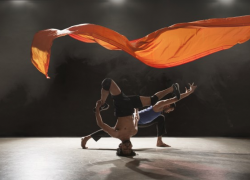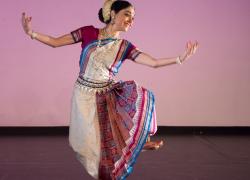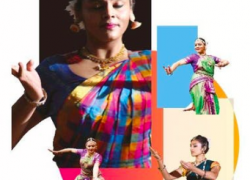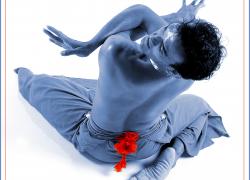Meghana Krishnan- Bharatanatyam Solo
Saraswatham Foundation
23 May 2021
Reviewed by Sooraj Subramaniam
Images: : Iyappan Arumugham, a4 Medias
In the Indian solo performing art forms, to portray and make swift transitions between all manner of characters refined or roguish, to evince from them a spectrum of emotions, and to articulate it all within highly stylised vocabularies, requires considerable skill. Meghana Krishnan—a bharatanāṭyam student of dancer-duo Renjith Babu and Vijna Vasudevan and other illustrious teachers amongst—did this with ease and panache in her virtual performance which screened on 23 May 2021 under the auspices of Chennai-based Sāraswatham Foundation.
Filmed conservatively and edited without gimmickry, this performance showcased bharatanāṭyam without fuss, straddling the space between archival recording and tasteful emulation of a live performance. It was refreshing to see the artist appear on screen as herself, in plain clothes, to introduce each of the works. Edited to include vignettes from the dances to come, these understated synopses were a welcome departure from their usually solemn ‘live’ counterparts.
The recital began with a puśpāñjali (symbolic salutation with flowers) in the sonorous Ārabhi rāga. The reposeful propitiating dance suggested a balance between the intimate (a direct greeting of the stage, fellow performers, and the audience) and the imperceptible (an allusion to the infinity of the cardinal directions). This segued into the softer Śrīrañjani rāga with a viruttam (verse) based on Ādi Śaṅkarācārya’s ‘Narasiṃha Karāvalambam Stōtram’, invoking the man-lion avatar of the god Viṣṇu.
Executing these musical transitions seamlessly was a stellar ensemble: Renjith Babu wielded the naṭṭuvāṅgam (cymbals) deftly; V. Vedakrishnan’s invigorating playing on the mṛdaṅgam (cylindrical drum) rooted the performance; K. P. Nandini Giridhar (violin) and B. Muthukumar (flute) were like shade and shadow in the evening skies. Nandini Anand Sharma, whose vocal timbre was mulled in the warmth of experience, offered a particularly nuanced performance: Kāmbhoji, a sweet and rather passionate rāga, was inflected with enough anguish to reflect the state of viraha (‘love in separation’) in the coming piece.
Nataraja Sundaram Pillai’s composition, ‘Nādanai azhaitu vā, sakhiye’, saw Meghana portray a nāyika (protagonist) beseeching a friend to fetch her beloved lord Murugā. Choreographed by veteran artist Prof. C. V. Chandrashekar, one witnessed a protagonist in the angst of unrequited love, assailed by Cupid’s arrows, and depleted by the anxiety of her yearning. The melodrama—the heartache of a prior dalliance; the swooning refusal of food and sleep; a trusty friend in-waiting to cushion the anguish—having percolated through the conventions of yesteryear coquetry, was charming and welcome. However, while the sentiments were true and imperishable—for who amongst us is impervious to the all-consuming earnestness of first love, say?—I was left quibbling over the saccharine nature of this lament. Had the script been too tightly wrought? Were the tropes too familiar? What might Meghana herself have brought to the script? These I felt were unanswered, the beauty of the work remaining aloof.
The levity of the nritta (abstract rhythmic dance) that interjects the expressive portions of such works stirs some debate: some welcome them as respite from the melodrama; others dismiss them as being mere virtuosic divertissements. Meghana managed to depict a suppleness and vulnerability throughout the rhythmic dance such that the narrative arc of the pining heroine was sustained. Two aspects shone like gems: Meghana’s jāru aḍavus (gliding steps) rippled through her body, her arms and torso elastic in their transitions before snapping back to form. The second, the complex kiṭatakatarikiṭatom that bests many a dancer, was the most luxurious I had witnessed: a generous backwards twist in the torso; the splendour of a Mughal arch in the arm curving overhead; the fractal flowering of the alapadma hand-gesture—fingers enunciating through space—before it shot forward like one of Love’s missiles. Without argument, simply exquisite!
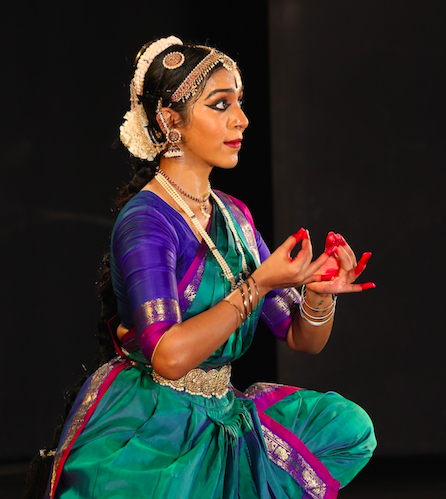
If the previous work was solemn and lofty, Dharmapuri Subbaraya Iyer’s ‘Indendu vachitivirā’ packed more punch for its brusqueness and brevity. A scornful heroine took her lover to task: “Did you imagine this was her street? Have you come here by mistake, adorned so wonderfully in your finery? Please go!” It was here that Meghana truly came into her own, her abhinaya (expressive technique) tantalising for its subtlety: narrowed glances and shrugged shoulders like lightning bolts streaking across a thunderous countenance. In some measure, I was consoled by the realness of this portrayal.
In Patnam Subbaraya Iyer’s ‘Samayam ide rā rā’ the tables were turned: the nāyika could not contain her glee as she bid her husband farewell and anticipated the arrival of her lover. The night—described in oblique metaphor as kamala-vairi (nemesis to the lotus)—was co-conspirator to this tryst. Urging him to exploit the blanket of darkness the protagonist said to her paramour: “My husband is away; my father-in-law is soundly asleep; don’t delay, come now!” Despite the reversed morals one sympathised completely with this plucky, unabashed character. For the daring frivolity of such poetic works, matched by the sauciness of the choreography— done here with verve by Renjith Babu—this was perhaps my favourite work.
The recital closed with ‘Galebhujaṅga’, a hymn to Śiva: undulating limbs and curved spatial patterns brought to life serpentine motifs to describe the mystic Lord. Tuned by Ustad Amjad Ali Khan to the unusual rāga Kalamaśrī, the composition was particularly beguiling for the syncopation of the orchestra: at one striking moment dance and music came to near stillness to depict the suspension of the mighty river Gaṅgā before she trickled from Śiva’s crown to earth. This was a sublime work—the descriptive motifs well-balanced against the abstract, inimitability of Śiva—once again showing the choreographic prowess of Renjith.
The hyperbole of these compositions notwithstanding, I return to the thought that the success of bharatanāṭyam in exposing the human condition depends on the ability of the artist to portray characters convincingly. Within an artform of superlatives—of myths and magic, of exuberance and ecstasy—Meghana’s ability to resist affectation and self-indulgence was remarkable. Her performance was honest and freeing, allowing her audience to be fellow meaning-makers in the experience.
A worthy recipient of her teachers Renjith and Vijna—themselves dazzling performers—Meghana Krishnan’s technique is precise and her aesthetic is understated, striking a balance between charisma and strength. She is a promising artist, and I certainly look forward to seeing more from her.
















